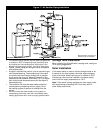
26
OPERATIONAL CONDITIONS
MAINTENANCE
Water Heater Sounds
During the normal operation of the water heater, sounds or
noises may be heard. These noises are common and may
result from the following:
1. Normal expansion and contraction of metal parts
during periods of heat-up and cool-down.
2. Sediment buildup in the tank bottom will create varying
amounts of noise and may cause premature tank fail-
ure. Drain and flush the tank as directed under “Drain-
ing and Flushing”.
Safety Shut-Off (Pressure Switch)
This water heater is equipped with a pressure switch that
protects the unit by shutting it down in the event that:
• A blockage occurs in the combustion air inlet, the
flue gas exhaust outlet, or both the inlet and outlet.
• The condensate line freezes and the condensate
“backs up” and fills the exhaust outlet.
• The blower fails to operate, or operates improperly.
• The unit begins to operate at an abnormally low
input level.
Energy Cut-Off (ECO)
A high temperature limit switch, or ECO, is used to shut down
the water heater if the water temperature exceeds 203°F.
The ECO will automatically reset when the temperature cools
sufficiently. If the ECO shuts down the heater repetitively,
contact a qualified professional for service.
Draining and Flushing
It is recommended that the tank be drained and flushed
every 6 months to remove sediment which may buildup
during operation. The water heater should be drained if
being shut down during freezing temperatures.
To drain the tank, perform the following steps:
1. Turn off the gas supply at the Manual Gas Shut-off
Valve. Turn off the electrical supply to the water
heater
2. Close the cold water inlet valve.
3. Open a nearby hot water faucet.
4. Open the access door at the bottom of the heater,
then connect a hose to the drain valve and
terminate it to an adequate drain.
Note: The drain hose should be rated for at least 200°F.
If the drain hose does not have this rating, open the cold
water inlet valve and a nearby hot faucet until the water is
no longer hot.
5. Close the cold water inlet valve.
6. Open the water heater drain valve and allow all
the water to drain from the tank.
7. Flush tank to remove sediment
Note: For water heaters with a hand hole clean-out follow
steps 8-11.
Figure 24
8. Remove screw holding the outer hand hole clean-out
cover. Then carefully remove the insulation covering
the clean-out plug. Using a 1/2” square drive ratchet
open the clean-out plug (see fi gure 23.) Note: After
removing the clean-out plug inspect the O-ring for dam-
age, replace if necessary.
9. Using a Wet/Dry shop vacuum clean any debris from
the tank.
10. Lubricate O-ring with a food grade oil. Then replace
and securely tighten the clean-out plug.
11. Replace the insulation and cover plate.
12. Close the drain valve, replace access door, refi ll
the tank, and restart the heater as directed under
“Operating Your Water Heater”.
If the water heater is going to be shut down for an extended
period, the drain valve should be left open.
Temperature and Pressure
Relief Valve
Manually operate the
temperature and pressure
relief valve at least once
a year to make sure it is
working properly. To prevent
water damage, the valve
must be properly connected
to a discharge line which
terminates at an adequate
drain. Standing clear of
the outlet (discharged
water may be hot), slowly
lift and release the lever handle on the temperature and
pressure relief valve to allow the valve to operate freely
and return to its closed position (see figure 24). If the valve
fails to completely reset and continues to release water,
immediately shut off the manual gas valve and the cold
water inlet valve, and call a qualified service technician.
Figure 23: Hand Hole Clean-out


















